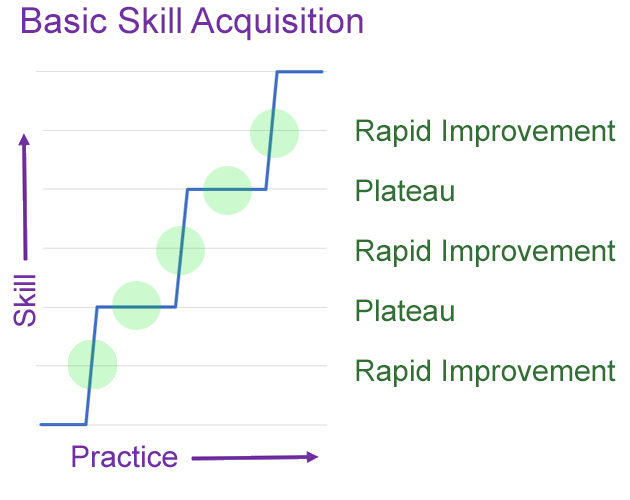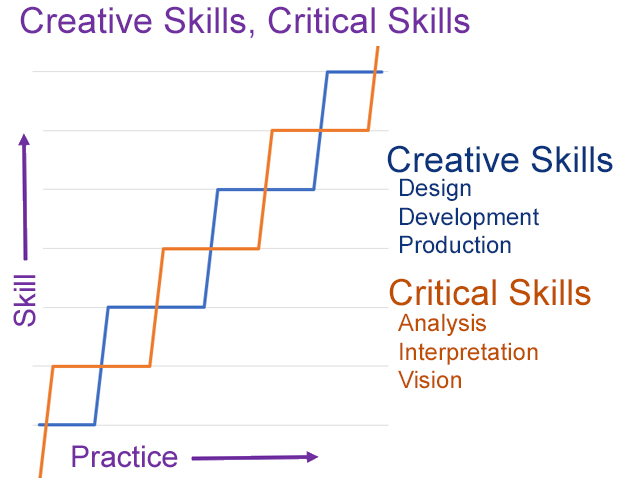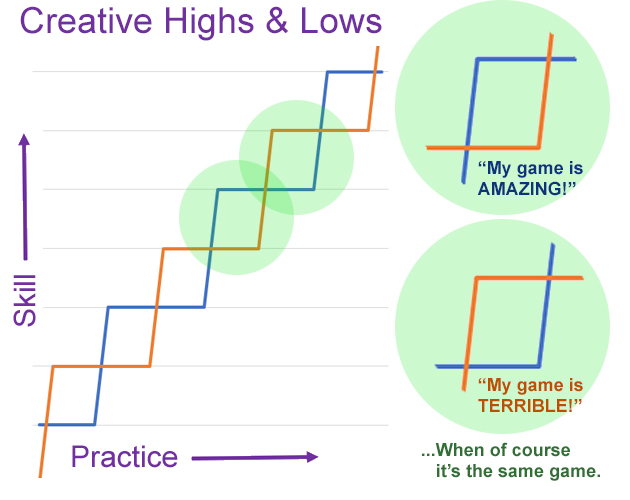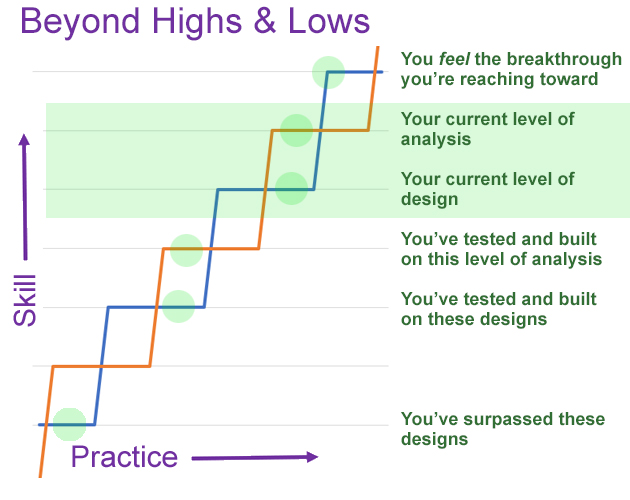This article was made possible by the generous support of my patrons. Please consider joining them by supporting me on Patreon.
Hello, my friends and fellow game designers!
There’s this chart that does the perennial rounds among my visual arts friends. It’s a skill acquisition chart, and it shows how we acquire skill at drawing out of step with our developing skill at seeing. If you have visual artists in your streams you’ve probably seen it.
It’s a useful and reassuring chart, and I wish the same info made the perennial rounds among game designers too. So I’m going to present it here, in steps, applied to skill at game design.
Chart 1: Skill Acquisition.

The more you practice a skill, the better you get at it. However, you get better in steps: rapid improvement, long plateau, rapid improvement, long plateau. Most of the time, you’re basically the same amount skilled as you were yesterday, and you’ll be the same amount skilled tomorrow. But periodically, you experience a rapid and dramatic improvement in skill, and leap up to the next long plateau.
Chart 2: Breakthroughs & Periods of Incorporation
But wait, there’s this thing that happens when you hop up to the next plateau.

You can see it clearly, watch it in real time, when you’re trying to beat Super Mario Brothers for the first time, so think back to that summer in 1986 or whenever the NES came out. (I suppose that those of you who are younger than me will have to think of a different video game.)
What happens is, you can’t beat a level, and you can’t beat it, and you can’t beat it for a long time – it’s above your current plateau, you see – and then suddenly you just completely nail it, you blow through the level like it was nothing, and you’re amazed. But then, the frustrating thing: you can’t do it again. You try and try and you can’t duplicate that breakthrough experience. Only gradually, after the breakthrough, does your skill level really and reliably reach its new plateau.
It’s too visually messy to include this breakthrough & incorporation process in the rest of these graphs, but please remember it’s there!
Chart 3: Creative & Critical Skills
So now let’s pull your skills apart, let’s say game design on one hand and game analysis on the other. Game design as a suite of creative skills, including design, development, and production; game analysis as a suite of critical skills, including understanding, interpretation, and vision. Making games vs understanding games.

As you work to develop your game design skills, you inevitably develop critical skills as well, but you develop them out of synch. You’re mid-plateau with one set of skills while you’re hopping up to the next plateau with the other. They leapfrog!
Chart 4: As Your Skills Surpass Each Other
Here’s my version of the chart that does the perennial rounds with my visual arts friends. It shows your subjective experience as your creative skills and your critical skills surpass and resurpass one another.

As your critical skills overtake your creative skills, you become aware and more aware of the failings and weaknesses of your creative work. Last week, your game design work was amazing; now, it’s like it’s getting worse right before your eyes.
Of course it’s not getting worse. It was good when you made it, and it’s good now. It’s your developing critical skills that make it seem worse than it was.
The lesson that this chart teaches, and it’s a valuable and reassuring lesson, is that your experience as a creator cycles. You’re a great game designer, then a mediocre one, then a great one again. Your game is as good as anybody else’s out there, then all you can see is how much better others’ games are than yours, and then you’re creating games again that are as good as the best games in the world.
If you follow a thousand game designers on Twitter like I do, you can watch this cycle play out every day! Every day, some of us are crowing about our designs, and some of us are bemoaning them, and we take turns, back and forth and back and forth. We’re all just working our way through the inevitable cycles of our creative work.
Aside: Emotional Cycles
This creative cycle would be hard enough to deal with all by itself, but of course what happens is, it layers on top of our ongoing personal emotional cycles and circumstances, whatever they happen to be. Anxiety? Depression? Isolation? Anger? Fragility?
When down cycles overlap and compound one another, it can turn into a real bad ride.
Chart 5: Taking a Longer View
So I don’t know about you personally, but I can tell you that for me, when my creative work cycles down, even when I’m in a good emotional place otherwise, I’m prone to overwhelm. Here’s how I try to deal with it instead.

When my critical skills outstrip my creative skills, I try to look back into the past beyond my current plateaus, to see the analysis and the designs that I’ve tested and built upon, and even further back to see the designs that I’ve genuinely surpassed.
And I try to experience my frustration not as frustration, but as a feeling of potential: I know that there’s another level of game design ahead of me. I’m not there yet, and I don’t even know for sure what it’ll be like, but I know that next breakthrough is coming. I can grasp and strive toward it.
This works pretty well for me. Maybe it’ll work for you too. When your critical skills outstrip your creative skills, it can feel bad, but it’s an essential part of the skill acquisition cycle.
Thanks
That’s what I’ve got. Thanks for reading!
Credit?
I haven’t been able to figure out where this insight originated and who to credit for it. I know that I brought the sawtooth breakthrough & incorporation chart with me from a language acquisition course I took in college. It’s possible that Shattered-Earth’s is the first version of the leapfrogging creative skills vs critical skills chart that I saw, and it’s likely that I first saw it because Joshua A.C. Newman shared it with me, but if you happen to know who I should be crediting here, please tell me.
Thank you for this insight, whoever’s it is!

Thanqol says:
Hi Vincent,
The first time I encountered this theory was from Sycra in 2012: https://youtu.be/Qb0g_gWrNf8
Vincent Baker says:
Awesome, thank you!
Ryan Stoughton says:
This model makes sense intuitively.
As a skill gets used by a wider group, should we expect tools to emerge? Tools that make the novice able to do more than their raw experience would allow?
Vincent Baker says:
Yeah!
A couple of months ago Meg and I joined a choir. First time I’ve sung formally in 25 years, and I’m struggling with the skill acquisition process pretty hard.
I can download recordings of the choir singing my part and sing along with them. I have sheet music and a keyboard I can hunt-and-peck on to find the right notes. Are these the kinds of tools you’re talking about?
Maximillien A Green says:
Hey Vincent!
I’m a fresh game designer and I keep starting projects amazed with what they can be, and then looking at them one day, dreading how awful I think they’ll play out.
I’ve done this 5 or 6 times and scraped nearly every game before I even playtest it.
This rad article really helps explain why I’m this way, but I can’t even dare to look back at the games that seem so awful to me.
What’s the next step? Will I ever finally make a game that I’m happy with playtesting? Or should I perhaps work on a game even if it feels like pulling teeth all the way through to the first beta test?
Thanks- loving burned over btw
Ryan Stoughton says:
Yes, but the examples you gave sound to me like they map to playing a game rather than Writing one.
The tools I’m thinking are the ones that help composing, like chord progressions, time signatures, metronomes, GarageBand
Ryan Stoughton says:
I mean you can say the forge archives, or design blogs, and things like the Power 19 can be useful. But the textbook or the guide to making games… it’s still like novel writing, and apprenticeship in reading.
Vincent Baker says:
Oh, yeah, no, now I see your point. I think you’re right.
Lobo Blanco says:
This theory makes sense of the sudden skill spike produced by games that use level rules … 🙂
edgarej says:
Thank you Vincent.
Can we write a wikipedia article about this concept? I am about to write my own article about this very graph and for the life of me I could not find a theory to discuss this. Every time I do a google search for perceived skill versus actual skill, google keeps serving me the Dunning-Kruger effect, which is a different graph than this. I really wish the graph has a name.
Anyways… I will be giving you credit in my article (and sycra too) since I don’t know who else I can give credit to this concept
Vincent Baker says:
Yes! Please do!